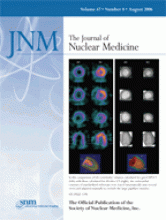TO THE EDITOR: We read with much interest the paper published by Garcia et al. (1) on an expert system for the diagnosis of renal obstruction using 99mTc-mercaptoacetytriglycine (MAG3) renography. Providing that an acceptable gold standard exists, a validated expert system may help an inexperienced observer in daily clinical work. Unfortunately, the diagnosis of renal obstruction is a matter of continuous controversy, because a gold standard is lacking. The only accepted definition of obstruction is indeed a retrospective one: “any restriction to urine flow, that left untreated, will cause progressive renal deterioration” (2). Thus, an expert system used for the diagnosis of renal obstruction should be based and validated on 2 series of patients with hydronephrosis, 1 corresponding to a simple dilatation, without any further renal deterioration, and 1 in which the conservative attitude resulted in kidney damage. The opinion of 3 experts, whatever the quality of their expertise, based on some renographic criteria, cannot be considered an acceptable substitute for a gold standard. Moreover, it is obvious that the renographic criteria on which the expert system relies, namely the MAG3 clearance and the parameters of drainage, are highly dependent on the way these parameters have been measured. As an example, let us examine critically the clinical case provided by the authors. The QuantEM renal quantification program designed by Taylor et al. (3) provides a reduced MAG3 clearance of 83 mL/min/1.73 m2, and the relative uptake is symmetric, thus suggesting that both kidneys have impaired function. This is rather difficult to accept because at least the left kidney is considered nonobstructed and because the early renographic images reveal an early high renal uptake with rapid disappearance of the heart activity. The level of overall function is not unimportant, particularly if a low clearance is accepted by the expert program as a criterion for obstruction. Concerning the drainage, one can observe that both the renal curves and the renal pelvis curves of the basic renogram look very similar. Under furosemide, the time to half-maximum counts (T1/2) for the left kidney is paradoxically longer than that for the right kidney, simply because the initial activity is lower on the left side than on the right side. It is easy to understand that, at the limit, in the case of an empty kidney at the beginning of a diuretic test, the curve would be horizontal. In the present case, the likelihood of right obstruction is probably based on the pelvic T1/2, which is much shorter on the left side. One can, however, argue about the way the T1/2 was obtained, and the uncertainties about the way to define T1/2 have often been underlined (4). For the left kidney, a fit has been determined on the first 5 min, whereas for the right kidney the entire curve has been considered. Using equal time intervals for both fits would probably have provided approximately the same T1/2 values. In conclusion, such an expert system is undoubtedly a valuable tool for the interpretation of a renogram, but its introduction in clinical practice should be delayed until a better agreement is reached on the definition of obstruction, on the renographic parameters to be used, and on the criteria applied for defining these parameters.
Footnotes
-
COPYRIGHT © 2006 by the Society of Nuclear Medicine, Inc.







